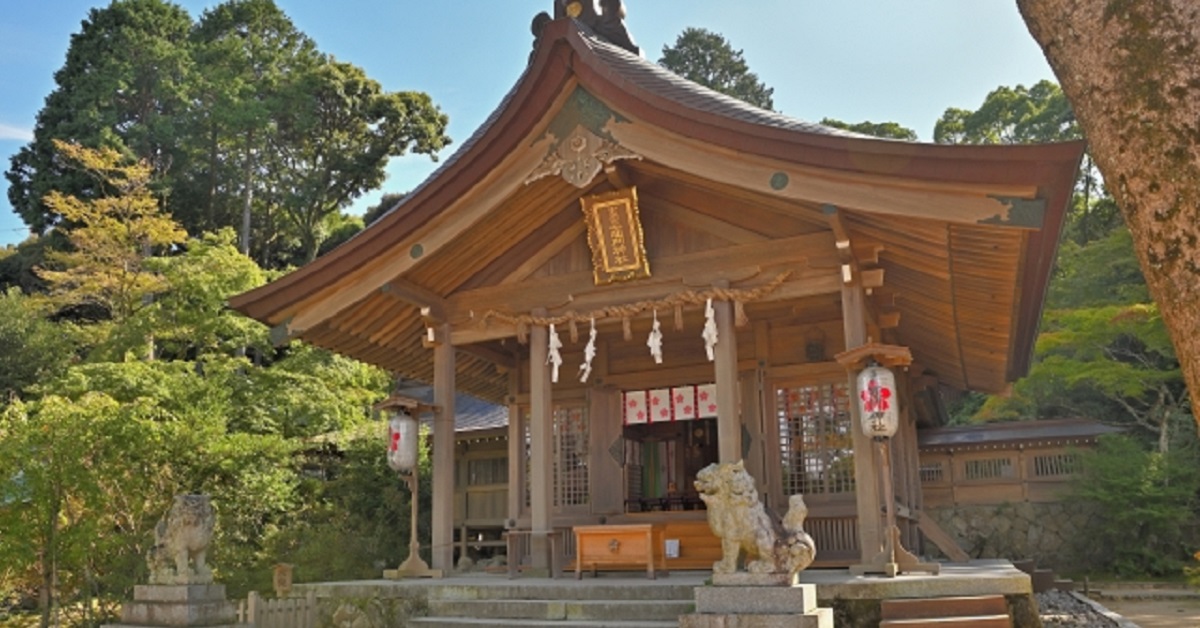Hōmangū Kamado Shrine, located in Dazaifu City, Fukuoka, is a historic shrine long revered as a god of matchmaking. In recent years, it has gained worldwide fame as a sacred site of the hit series Demon Slayer, attracting countless visitors from across Japan and beyond.
History and Origin of Hōmangū Kamado Shrine
The origins of Hōmangū Kamado Shrine date back to the 7th century. It was built to protect the northeastern “kimon” (demon gate) of the Dazaifu government office, a direction traditionally considered vulnerable. The enshrined deity is Tama Yorihime no Mikoto, who has been revered as a divine guardian of matchmaking, fortune, and warding off evil for centuries.
The shrine is deeply connected with Mount Hōman, a sacred site of Shugendō (mountain ascetic practices). From its grounds, visitors can gaze over the city of Dazaifu, sensing why this place has been venerated as holy since ancient times.
In recent years, attention has grown because the shrine shares the name “Kamado” with Tanjiro Kamado, the protagonist of Demon Slayer. This coincidence has made the shrine a popular destination for fans nationwide.
Connection with Demon Slayer
Although Hōmangū Kamado Shrine is not directly featured in the series, the shared name made it a “sacred site” for fans. Visitors often draw characters such as Tanjiro or Nezuko on ema (wooden plaques) and dedicate them as prayers, creating a special bond with the story.
The number of young visitors and families surged after the anime aired, and the shrine grounds are now filled with excitement and devotion from fans.
| Fan Activity | Description |
|---|---|
| Ema dedication | Draw Tanjiro, Nezuko, or other characters and dedicate wishes |
| Sacred pilgrimage | Feel the connection between the shrine’s name and characters |
| Amulet collection | Seek limited-edition shrine charms linked to the series |
| Photo spots | Take pictures at the torii gates or pathways evocative of the story |
Matchmaking and Blessings
Hōmangū Kamado Shrine is widely known as the “god of matchmaking”. Its blessings are not limited to romance but also extend to positive encounters in friendships, work, and life in general.
The shrine’s main blessings include:
| Type of Blessing | Meaning |
|---|---|
| Matchmaking | Love, marriage, and personal connections |
| Protection from misfortune | Warding off disasters and maintaining peace |
| Good fortune | Raising luck and supporting new challenges |
| Household safety | Ensuring family health and prosperity |
The shrine is especially popular with women and couples, often drawing long lines of visitors on weekends.
Highlights of the Shrine Grounds
Surrounded by the natural beauty of Mount Hōman, the shrine grounds are full of places that soothe the heart.
- Main Hall: A solemn structure radiating ancient reverence.
- Pathway: Seasonal beauty with cherry blossoms in spring and fiery autumn leaves.
- Shrine Office: Offers charms, ema, and special items for Demon Slayer fans.
- Trailhead to Mount Hōman: A starting point for faith-based mountain climbing and hiking.
| Season | Shrine Highlights |
|---|---|
| Spring | Pathways covered in cherry blossoms |
| Summer | Lush greenery and cool mountain breezes |
| Autumn | Brilliant autumn leaves creating a mystical atmosphere |
| Winter | Snow-covered main hall with a sacred stillness |
Enjoying the Shrine by Season
The shrine changes its charm with the four seasons, each offering a unique experience.
- Spring: A tunnel of cherry blossoms creates a magical walkway.
- Summer: Green foliage and refreshing breezes greet visitors.
- Autumn: The grounds glow with breathtaking autumn leaves, attracting photographers.
- Winter: Snow transforms the shrine into a mystical, silent sanctuary.
| Season | Visitor Experience |
|---|---|
| Spring | Combine hanami (flower viewing) with worship |
| Summer | Enjoy hiking and cool air |
| Autumn | Leaf-viewing and photography |
| Winter | Quiet worship and snow scenery |
Access to Hōmangū Kamado Shrine
The shrine is easily accessible from central Dazaifu. From Nishitetsu Dazaifu Station, take the community bus “Mahoroba-go” for about 10 minutes.
Many visitors combine a trip to Dazaifu Tenmangū, creating a route to pray for both academic success and matchmaking.
| Transportation | Time | Notes |
|---|---|---|
| Bus | ~10 minutes from Nishitetsu Dazaifu Station | Mahoroba-go route |
| Walking | ~40 minutes from Dazaifu Tenmangū | Scenic pilgrimage walk |
| Car | ~20 minutes from Dazaifu IC | Parking available (crowded on holidays) |
Lodging and Nearby Attractions
Visitors often combine a shrine visit with local sightseeing. Dazaifu offers lodging, restaurants, and cultural spots to explore.
| Nearby Spot | Feature |
|---|---|
| Dazaifu Tenmangū | Famous nationwide for enshrining Sugawara no Michizane, the god of learning |
| Kyushu National Museum | Exhibits on cultural exchange between Japan and Asia |
| Umegae Mochi Shops | Local sweet, a must-try treat after worship |
| Kanzeon-ji Temple | Founded in the Nara period, housing national treasures |
Eating Umegae Mochi, a grilled sweet rice cake filled with red bean paste, is a highlight after visiting the shrine.
Conclusion
Hōmangū Kamado Shrine is a historic spiritual site in Dazaifu City, celebrated for matchmaking, protection, and fortune. In recent years, it has also gained fame as a sacred site of Demon Slayer: Kimetsu no Yaiba, attracting fans who dedicate ema, collect charms, and celebrate their love for the series.
The shrine combines tradition, faith, and modern culture, offering visitors blessings and inspiration. With its stunning seasonal landscapes, it provides both spiritual and emotional fulfillment.
Hōmangū Kamado Shrine will continue to shine as a hub where belief, tourism, and culture converge, drawing countless people from across Japan and beyond.






